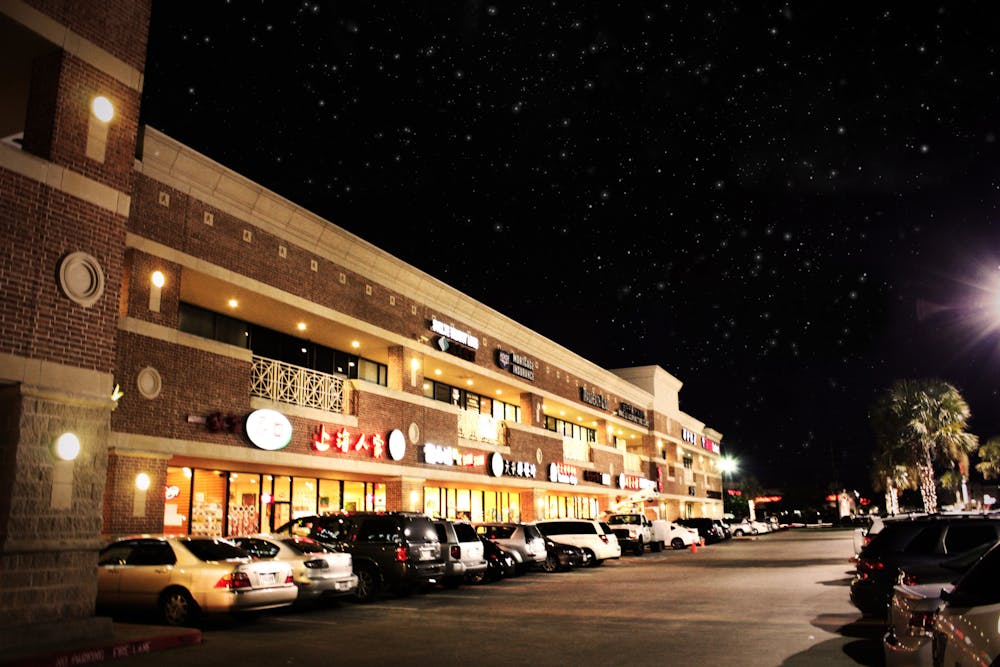
The roast duck at Alan’s deli next to Great Wall supermarket hangs in a neat row, skewered in place by the neck and dripping with oil. My mom half-shouts to be heard over the sound of a chopping knife as she orders duck, char siu and crispy pork belly from the man behind the counter.
She hands me the bag of stacked styrofoam boxes. I carefully hold it with both hands, one hand grabbing the knot at the top and the other balanced underneath.
Sundays often follow this routine. After church, we drive to Chinatown, arguing over what we want for dinner on the car ride there. The plazas are always packed with cars, the parking is non-existent, and every inhale of air comes with the sour tang of pollution, yet the place elicits only fond memories.
In Houston’s Chinatown, popular spots include Ming Xing, a perpetually busy eatery that sells everything from boba to dumplings to calamari for super cheap; Tan-Tan, a family style restaurant that opens until 3 a.m. on weekends; and ShareTea, a popular boba chain.
Each restaurant, bakery and boba shop lining the streets is attached to memories of birthday dinners, late night hangouts and family celebrations.
Seven Leaves is where my friends and I studied junior and senior year of high school. We lived in an area with few good options for Asian food and boba, so despite the half hour drive, we went all the way to Chinatown to study. In a packed cafe, inches apart from the other customers, we sipped on milk tea and completed chemistry problems. I finished my college essays at this cafe, where I laboriously typed with the support and sympathy of friends.
For a short while, a Korean restaurant called Tofu Village was a favorite dinner spot for my family. My parents always got galbi and spicy tofu soup while my sister and I shared a kimchi pancake and bibimbap. The side dishes were especially good, little plates of creamy mashed potatoes, seaweed salad and tangy red-and-white kimchi.
Six Ping and 85c were popular bakeries, but we always paid a visit to King Bakery, sandwiched between a Taiwanese dessert cafe and noodle house. My mom griped and groaned about how the shelves were never stocked and the decorations were tacky, but she came back every time for egg tarts and bo lo baau, or pineapple buns.
We usually celebrated holidays with hot pot at home, spending the day before buying ingredients. We bought fish balls from the grocery store a few blocks away from an old boba place. The fish balls were stored in a freezer box at the front of the store with half-torn plastic labels, and I would fill a bag with the flavors and fillings I wanted. Then, we’d walk around the store and look at mismatched plates and cups and pick up a box of red bean popsicles before paying.
Chinatown represents not only fond childhood memories but the growth of immigrant populations in America and the cultural diffusion that results. The first significantly populated Chinatown originated in San Francisco in the 1850s as a way to support the politically and socially marginalized Chinese community. Although these ethnic enclaves began as places of refuge from racial discrimination, they also became beloved cultural landmarks and a large part of the Asian American experience.
Being Asian American is sometimes awkward. The American part of the compound is often more influential. I watch American TV, read books in English, listen to American news, learn American sayings, act American, think American. I may speak some Cantonese and eat Chinese food and visit China occasionally, but I don’t understand neither the intricacies of Chinese politics nor the sayings or slang of the language. I don’t know the customs or habits that come with growing up and living in China.
However, despite the fact that I have only ever known an American way of doing and saying and being, I am seen by other Americans as slightly foreign. Being Asian American is finding an identity in between two different worlds that is distinctly its own.
In some ways, Chinatown is the perfect analogy for the Asian American identity, and not just because it is commonly frequented by Asian Americans. It is an ethnic enclave in a diverse country that can be both welcoming and hostile to minorities. It is shaped by both Asian and American influences, and yet, it isn’t entirely one or the other.
Chinatown is just Chinatown.





